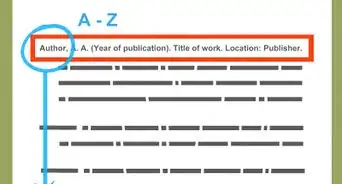This article was co-authored by wikiHow Staff. Our trained team of editors and researchers validate articles for accuracy and comprehensiveness. wikiHow's Content Management Team carefully monitors the work from our editorial staff to ensure that each article is backed by trusted research and meets our high quality standards.
wikiHow marks an article as reader-approved once it receives enough positive feedback. In this case, 88% of readers who voted found the article helpful, earning it our reader-approved status.
This article has been viewed 98,700 times.
Learn more...
Citing Shakespeare in MLA style can be tricky, as you may not be sure how to cite the act, verse, and line numbers, rather than page numbers. To follow MLA style, you will need to properly format any quotes from Shakespeare in the text and use in-text citations accordingly. You should also cite Shakespeare in the bibliography at the end of your paper. Whether you are citing Shakespeare in MLA for a paper for class or an essay for a reading assignment, you can get the citations right with just a few steps.
Steps
Formatting Shakespeare Quotes in Text
-
1Put a single line of verse in quotation marks. If you are only citing 1 line of verse from a work by Shakespeare, use quotation marks around the line of verse. Make sure you include all punctuation in the quotation marks.[1]
- For example, you may write, “Prospero feels doomed by his decision, stating: ‘Hell is empty.’”
-
2Use slashes when quoting 2-3 lines of verse. If you are using a quote that contains more than 1 line of verse, separate each line with a slash (/). This will help the reader understand the verses appear on separate lines. You need to put a space on either side of the slash.[2]
- For example, you may write, “In the play, Prospero refers to the temporality of life, noting: ‘We are such stuff as dreams are made on/and our little life is rounded with a sleep.’”
Advertisement -
3Set more than 3 lines of verse in block quotes. If you are including a longer quotation from the play that spans 3 or more lines, start the quotation on a new line, 1 inch (2.5 cm) from the left margin. Do not use quotations around the quote.[3]
- For example, you may write, "The character Ariel tries to soothe with a song that describes fear as fleeting:
Full fathom five thy father lies;
Of his bones are coral made;
Those are pearls that were his eyes:
Nothing of him that doth fade,
But doth suffer a sea-change
Into something rich and strange.
Sea-nymphs hourly ring his knell: Ding-dong
Hark! now I hear them,—Ding-dong, bell."
- For example, you may write, "The character Ariel tries to soothe with a song that describes fear as fleeting:
-
4Use block quotes to quote dialogue between characters. Apply the same block quote formatting, 1 inch (2.5 cm) from the left margin. Begin each section of dialogue with the character’s name in capital letters. Put a period after the character’s name, followed by the quotation. Indent any subsequent lines spoken by the character 1⁄4 inch (0.64 cm) from the left margin. Start a new line when the dialogue shifts to a new character and do not use quotation marks.[4]
- For example, you may write: "The play’s first moment of betrayal involves two characters abandoning their authority figure:
ANTONIO. Let's all sink wi' th' king.
SEBASTIAN. Let's take leave of him."
- For example, you may write: "The play’s first moment of betrayal involves two characters abandoning their authority figure:
Creating an In-Text Citation
-
1Place parentheses at the end of the quotation. In-text citations should always appear at the end of the quotation in parentheses, even if you are citing 3 or more lines of text in a block quote. The quotation should appear after the last line in the block quote.[5]
- For example, you may write, “Prospero feels doomed by his decision, stating: ‘Hell is empty/and all the devils are here.’ (1.2.15-16.)”
- An example with block quotes would be, "The play’s first moment of betrayal involves two characters abandoning their authority figure:
ANTONIO. Let's all sink wi' th' king.
SEBASTIAN. Let's take leave of him. (1.1.4-5)"
-
2Abbreviate and italicize the title of the play. Start the in-text citation with the title of the play. Abbreviate the title of the play according to the MLA guidelines and italicize the abbreviation.[6]
- You can find a complete list of abbreviations for the titles of Shakespeare’s plays on Internet Shakespeare Editions: http://internetshakespeare.uvic.ca/Foyer/guidelines/abbreviations/.
- If you are only discussing one play by Shakespeare in your paper and you refer to the play once already in your paper, you do not need to include an abbreviation of the title in subsequent citations.
- For example, you may write a citation from Macbeth as, “A good example of foreshadowing is spoken by the second witch, ‘By the pricking of my thumbs,/Something wicked this way comes.’ (Mac. 4.1.57-58)”
- Or, if you have already referred to the play once, you leave the “Mac” out of the citation, using just the numbers, “(4.1.57-58).”
-
3Note the act, scene, and line numbers, separated by periods. Use numbers, rather than Roman numerals, to note these details. You do not need to include the words “act,” “scene,” or “line,” in the citation, just the numbers. Use a dash between the line numbers if the quotation spans more than one line.[7]
- For example, you may write, “A good example of foreshadowing is spoken by the second witch, ‘By the pricking of my thumbs,/Something wicked this way comes.’ (4.1.57-58.)” This means the quotation comes from Act 4, scene 1, lines 57-58.
-
4Include a numeral citation when referring to the play in a sentence. If you want to refer to the act and scene of the quotation in a sentence, use numbers rather than Roman numerals. You do not need to include the words “act” or “scene” when referring to the quotation in a sentence.[8]
- For example, you may write, “In 4.1, the second witch provides a few lines of foreshadowing.”
Citing Shakespeare in a Bibliography
-
1Start with the author and the title. List the author by last name and then first name, Shakespeare, William. Note the full title of the play in italics. Separate the author and the title with periods.[9]
- For example, you may write, “Shakespeare, William. The Tempest.”
-
2Include the name of the editor. Look up the name of the editor in the print text or online text. It usually appears on the back of the title page in the text. Write “Ed.” and then the editor’s full name. Include more than 1 editor if there are several.[10]
- For example, you may write, “Ed. Tucker Brooke” or “Ed. John Keene and Lawrence Mason.”
-
3List information about the publisher. Note the city where the text was published as well as the name of the publisher and the year of publication.[11]
- For example, you may write, “New Haven, Yale University Press, 1947.”
-
4Note the medium of the play. Write “Print” if you accessed the play in print form. Use “Web” if you accessed the play online.[12]
- For example, the complete citation would be: “Shakespeare, William. The Tempest. Ed. Tucker Brooke. New Haven, Yale University Press, 1947. Print.”
-
5Cite the editor’s name first if your citations are from the editor’s work. If you used the editor’s notes and editorial changes or decisions for the majority of your quotations, include the editor’s name first in your citation. You will also need to include the publisher information.[13]
- For example, you may write, “Furness, Horace Howard, ed. The Tempest. By William Shakespeare. New York, Dover, 1964. Print.”
-
6Include additional information if you are citing an anthology. If you are accessing the play from an anthology or collection of Shakespeare’s plays, make sure you cite this properly. You will need to include the name of the anthology or collection in the citation as well as the editor and publisher information. You should also include the page numbers you accessed the anthology.[14]
- For example, if you were citing an anthology with one volume, you would write, “Shakespeare, William. Macbeth. The Riverside Shakespeare. Ed. G. Blakemore Evans. Boston, Houghton Mifflin, 1974. 1306-42. Print.”
- For an anthology with more than one volume, you would note the volume number you accessed: “Shakespeare, William. As You Like It. The Annotated Shakespeare. Ed. A. L. Rowse. Vol. 1. New York, Clarkson N. Potter, 1978. 334-89. Print.”
Community Q&A
-
QuestionHow do you format more than two lines in a play by Shakespeare? Do you use a / when citing more than one line?
 Community AnswerYes -- when those two lines are written in verse. If they are prose lines (such as when Hamlet is pretending to be mad), there is no need to use a slash to separate them.
Community AnswerYes -- when those two lines are written in verse. If they are prose lines (such as when Hamlet is pretending to be mad), there is no need to use a slash to separate them. -
QuestionWhat if the edition is online and does not have a published date?
 TorpiTop AnswererDouble-check for any information at all indicating when the page was uploaded or last edited. If it exists, use that as the date. Otherwise, skip the date in your in-text citations. For your bibliography, add the website title in italics, after all of the other information. Then, add the URL or DOI of the page (DOI is better if you have it - but if you don't know what that is, don't worry about it). Finish the citation with "Accessed" and then the date you last accessed the page, in Day Month Year format (e.g. "Accessed 16 May 2020").
TorpiTop AnswererDouble-check for any information at all indicating when the page was uploaded or last edited. If it exists, use that as the date. Otherwise, skip the date in your in-text citations. For your bibliography, add the website title in italics, after all of the other information. Then, add the URL or DOI of the page (DOI is better if you have it - but if you don't know what that is, don't worry about it). Finish the citation with "Accessed" and then the date you last accessed the page, in Day Month Year format (e.g. "Accessed 16 May 2020"). -
QuestionIs this for MLA 8 or an older version?
 Sarah Jane BurkeCommunity AnswerYou must always cite using the most recent updated referencing system for your academic category. English is MLA 8th edition. Most universities have referencing guides on the websites which are accessible to the public. It it good practice to write it by hand so you gain muscle memory for the correct layout. Alternatively, if you are short of time there are referencing websites that have engines which will generate the reference for you, you only need to supply the book's details.
Sarah Jane BurkeCommunity AnswerYou must always cite using the most recent updated referencing system for your academic category. English is MLA 8th edition. Most universities have referencing guides on the websites which are accessible to the public. It it good practice to write it by hand so you gain muscle memory for the correct layout. Alternatively, if you are short of time there are referencing websites that have engines which will generate the reference for you, you only need to supply the book's details.
References
- ↑ https://www.southplainscollege.edu/exploreprograms/artsandsciences/english/HowtoCiteShakespeareinMLA.pdf
- ↑ http://drmarkwomack.com/mla-style/how-to-quote/quote-shakespeare/
- ↑ http://drmarkwomack.com/mla-style/how-to-quote/quote-shakespeare/
- ↑ http://drmarkwomack.com/mla-style/how-to-quote/quote-shakespeare/
- ↑ https://www.southplainscollege.edu/exploreprograms/artsandsciences/english/HowtoCiteShakespeareinMLA.pdf
- ↑ https://www.southplainscollege.edu/exploreprograms/artsandsciences/english/HowtoCiteShakespeareinMLA.pdf
- ↑ https://www.southplainscollege.edu/exploreprograms/artsandsciences/english/HowtoCiteShakespeareinMLA.pdf
- ↑ http://drmarkwomack.com/mla-style/how-to-quote/quote-shakespeare/
- ↑ https://penandthepad.com/correct-way-cite-shakespearean-works-4219.html
- ↑ https://penandthepad.com/correct-way-cite-shakespearean-works-4219.html
- ↑ https://penandthepad.com/correct-way-cite-shakespearean-works-4219.html
- ↑ https://penandthepad.com/correct-way-cite-shakespearean-works-4219.html
- ↑ http://web.lsue.edu/docs/library/MLA-PLAY.pdf
- ↑ http://web.lsue.edu/docs/library/MLA-PLAY.pdf
About This Article
To cite Shakespeare in a bibliography using MLA format, list “Shakespeare, William” as the author and follow with the full title of the play in italics. Include the name of the editor by writing “Ed.” and then the editor’s full name. Write the city where the text was published, the name of the publisher, and the year of publication. Finally, list the medium of the play, such as “Print” or “Web,” depending on how you accessed the play. For more guidance, including how to create an in-text citation and format Shakespeare quotes, read on!


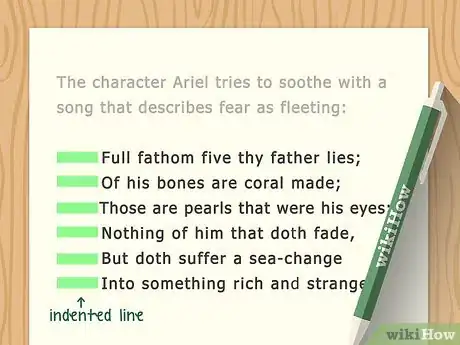

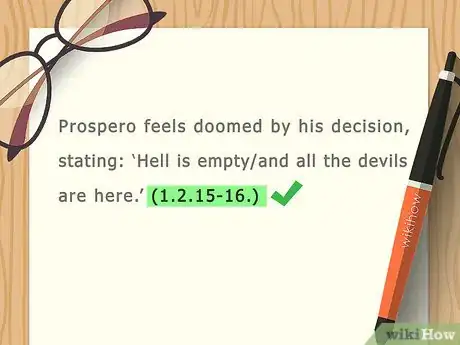
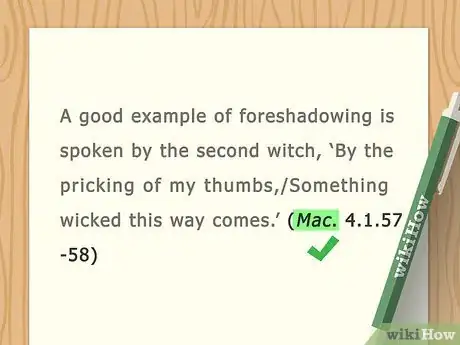
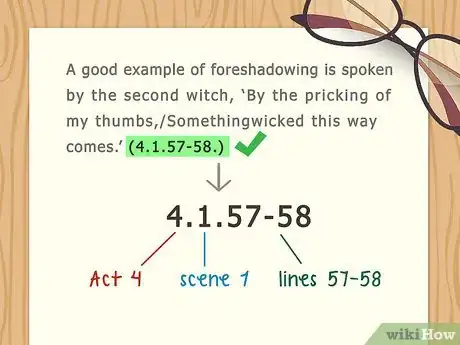


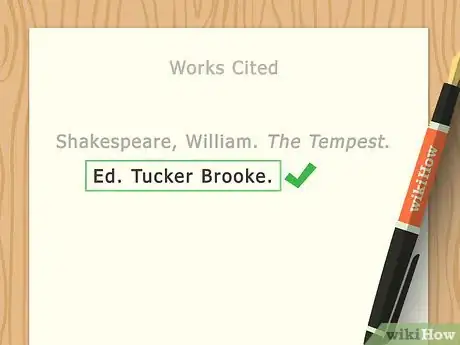
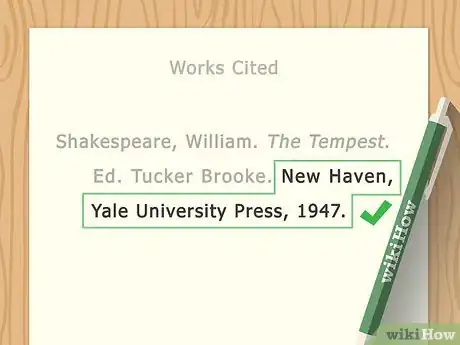
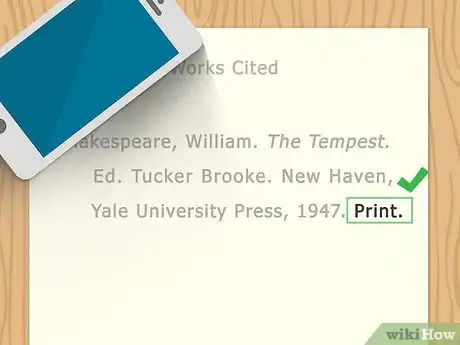
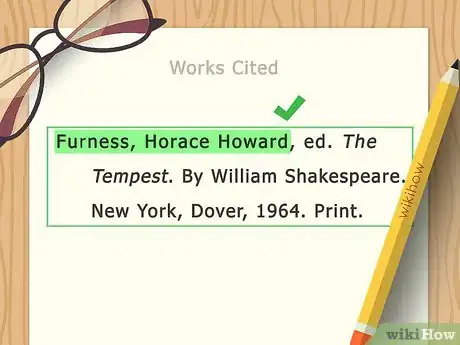
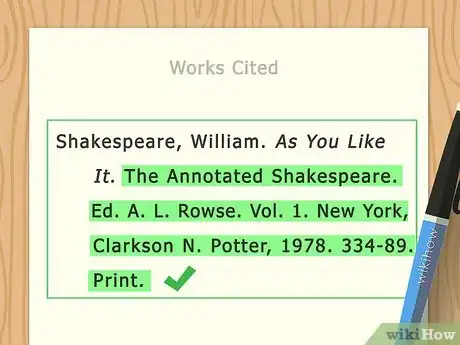








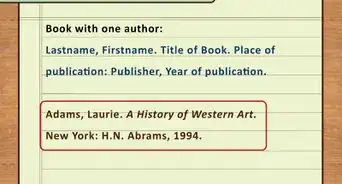

-Step-18.webp)

